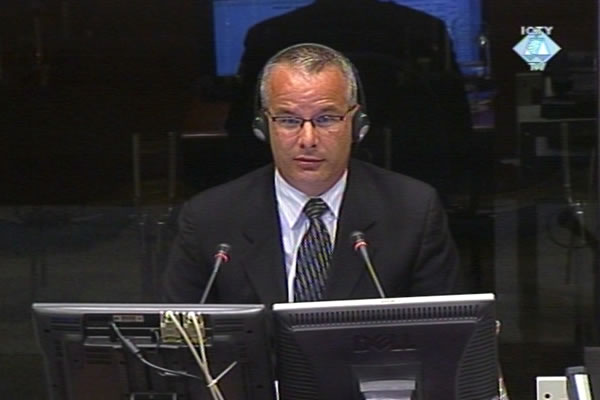Home
LOOTING OR CONFISCATION?
Gotovina’s defense counsel tried to prove today that on their arrival in Knin after Operation Storm Croatian soldiers confiscated goods from government and military facilities. The witness maintained that the goods were looted from civilian apartments. The witness saw the military police stopping soldiers and civilians at check-points but never saw any stolen property taken from them
 Murry Dawes, witness in the Gotovina trial
Murry Dawes, witness in the Gotovina trial Murray Dawes, former civilian clerk serving in the UN mission, admitted in his cross-examination that in the days after the shelling that had occurred on 4 and 5 August 1995, Knin looked ‘much better’ than he and UN colleagues had expected. Other witnesses before him had said the same thing. He did maintain though that the Croatian Army targeted civilian buildings in the town. Dawes was cross-examined by Ante Gotovina’s defense counsel today; the defense teams of Ivan Cermak and Mladen Markac had no questions for him.
Defense counsel Kehoe first put it to the witness that on 4 August 1995 when he was slightly wounded in Knin Dawes didn’t know whether he was within the range of the Croatian artillery at the time of the impact. Therefore, the witness was not able to tell where the shell came from. The witness agreed saying that he ‘doesn’t know’ who fired the shell at him.
In an effort to challenge Dawes’s allegations of ‘systematic and organized’ looting of Knin after the arrival of the Croatian Army, the defense counsel suggested that the goods were taken from the facilities used by the army and government of the former RSK, and not from residential buildings. Dawes, however, stuck to his claim that he witnessed the soldiers carry TV sets, video recorders, stereos and other appliances out of apartments and not government buildings. The defense counsel picked up from that, saying that Serb army personnel might have lived there. Dawes replied that he didn’t know that; what he knew was that UN staff lived in some of those buildings.
The defense counsel went on to show several documents drafted by the Croatian Army units in August 1995 with lists of goods confiscated in Knin. When asked if he saw the military police stop soldiers and civilians at check-points and take stolen items from them, the witness replied tersely, ‘They did stop them, but they didn’t take anything’.
When he described the looting and destruction of Serb houses in the villages of Vrbnik and Kistanje on 6 August 1995, Dawes marked the route he took that day. The defense counsel pointed that the route he had drawn crossed the river at a spot where there was no bridge. As the defense counsel alleged, this means that the witness never made that visit to villages in Krajina. The witness explained that in his examination-in chief he had marked a ‘general route’; it might not have been very precise, he admitted.
The defense counsel didn’t ask the witness about the looting and burning down of houses along the Drnis-Knin road on 8 August 1995 he described in his examination-in chief.
Linked Reports
- Case : Gotovina et al. - "Operation Storm"
- 2008-10-13 ‘ORGANIZED DISMANTLING OF THE TOWN’
- 2008-10-10 LOOTED GOODS NOT EVIDENCE OF LOOTING
- 2008-10-09 ‘ADDITIONAL EXPLANATIONS’
- 2008-10-15 HOW TO RECOGNIZE LOOTED GOODS
- 2008-10-16 ‘I DIDN’T THINK I’D SURVIVE’
- 2008-10-21 PROSECUTION REQUESTS DOCUMENTS IT ALREADY HAS?
